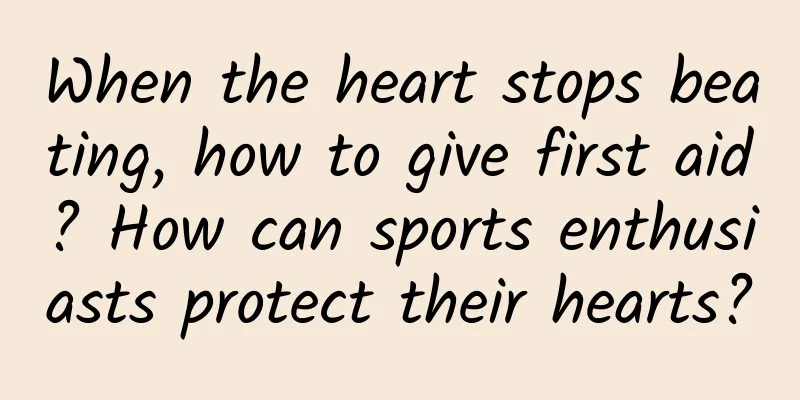When the heart stops beating, how to give first aid? How can sports enthusiasts protect their hearts?

|
"The world is just an hourglass of memories, like a falling meteor, brilliantly lighting up the entire starry sky, just like the unfading wound left by your story in my life..." - G.E.M. Deng's "Hourglass of Memories" Image source: soogif 01Breaking the "Hourglass" of Pause in Life Often, we hear news like this: someone collapses during exercise and never wakes up again because of cardiac arrest. According to national statistics, the total number of people who die of sudden cardiac death is as high as more than 500,000 each year. On average, someone dies from cardiac causes within 1 hour of onset every minute, and the success rate of rescue is less than 1%. Cardiac arrest is like a car engine suddenly stalling while driving, which is equivalent to pressing the "pause button" on life. If it cannot be "restarted" within the countdown of the hourglass, it means that life will stop forever. Whenever a sudden cardiac death incident appears in the news, it is accompanied by a voice of regret, "Why didn't you take emergency measures earlier?" Image source: Pixabay Cardiopulmonary resuscitation (CPR) is the first aid measure for cardiac arrest, and it is like the key to a car, reopening the door to life. Currently, the American Heart Association (AHA) regularly updates the cardiopulmonary resuscitation guidelines to improve the effectiveness of treatment. However, many people may not know that the inventor of CPR was Professor Wang Yuanchang of the Department of Anesthesiology at Tianjin Medical University in my country. His CPR during epidural anesthesia was 5 years earlier than reported abroad. Professor Wang is known as the "world's first person to perform external chest compressions." 02Traditional CPR The traditional cardiopulmonary resuscitation process is divided into three stages: basic life support (BLS), advanced life support (ALS) and post-resuscitation care (PRC). Image source: provided by the author BLS, also known as initial resuscitation or cardiopulmonary resuscitation, refers to first aid measures at the scene where there is a lack of resuscitation equipment and technical conditions. The purpose is to quickly and effectively restore blood perfusion to vital organs. It is something that ordinary people can learn and master in emergency situations. Signs of successful BLS resuscitation are: arterial pulsation, spontaneous breathing, ruddy complexion, limb movement, pupil constriction, etc. After successful BLS resuscitation, the patient will enter the next stage, ALS, which means transfer to the hospital ICU for treatment. 03High-quality CPR teamwork The latest CPR does not simply include cardiac compression and artificial respiration. Strictly speaking, it is a teamwork work, called "high-quality CPR teamwork", which includes two parts: high-quality CPR + teamwork. So what is high quality? 1. The Law of Time Hurry! Race against time in the "Survival Chain", 1 minute for platinum and 4 minutes for gold, and each operation should not pause for more than 10 seconds. 2. High-quality cardiopulmonary resuscitation Press quickly, 100-120 times/minute; press hard, with a depth of 5-6 cm (1/3 of the anterior-posterior diameter of the chest); the compression-to-breathing ratio is 30:2; the chest rebounds with each compression, and the compression-to-relaxation ratio is roughly equal; press continuously without interruption; avoid excessive ventilation. 3. Teamwork High-quality cardiopulmonary resuscitation requires high requirements and frequent professional content needs to be completed in a short period of time, so it is difficult to complete it by one person alone and requires teamwork. This team is temporary and is quickly formed and divided into leaders, compressions, artificial respiration (airway), defibrillation, injections, medication and recording. Image source: provided by the author 04Exercise and Cardiac Arrest There are many scenarios in which sudden death due to cardiac arrest can occur, such as irregular work and rest schedules, high work and life pressure, staying up late and working overtime for a long time, etc., but it seems that more people experience it during exercise. However, current medical research has not found a causal relationship between the two. If you are still worried, people who love exercise can avoid or reduce the risk of cardiac arrest by exercising in a scientific way and having regular physical examinations. One of the methods is the AHA-recommended method of determining training intensity based on heart rate, which is called heart rate reserve training. Heart rate reserve training measures the intensity of training according to the percentage of the heart rate during training to the maximum heart rate. The maximum heart rate is "220-age". For example, for a 20-year-old, the maximum heart rate is 220-20=200 beats/minute. Moderate exercise intensity is 50%-70% of the maximum heart rate, and vigorous exercise intensity is 70%-85% of the maximum heart rate. Image source: Pixabay Exercise intensity and duration recommendations for adults: 1. Perform at least 150 minutes of moderate-intensity aerobic exercise per week or 75 minutes of vigorous-intensity aerobic exercise per week, or a combination of the two, preferably in divided sessions. 2. Add moderate to high intensity muscle strength training (such as resistance or gravity training) at least 2 days a week. 3. Sit less. Even low-intensity activities can offset the harm of sitting for long periods of time. 4. More than 300 minutes (5 hours) of activity per week is more beneficial to the body. 5. Exercise regularly over a long period of time, and gradually increase the weekly exercise time and intensity. Recommendations for exercise intensity and duration for children: 1. Children aged 3-5 are physically active and have enough opportunities to be active every day. 2. Children aged 6-17 years should engage in at least 60 minutes of moderate to vigorous intensity physical activity every day, mainly aerobic activity. 3. Perform high-intensity exercise at least 3 days a week. 4. Muscle and bone strengthening (weight-bearing) exercise at least 3 days per week. 5. Exercise regularly over a long period of time, and gradually increase the weekly exercise time and intensity. Source: Chongqing Science and Technology Museum Author: Tang Hao, PhD, Associate Chief Physician, Critical Care Medicine, Army Specialty Medical Center Review experts: Huang He, Li Chunli, Xu Xiaoping Statement: Except for original content and special notes, some pictures are from the Internet. They are not for commercial purposes and are only used as popular science materials. The copyright belongs to the original authors. If there is any infringement, please contact us to delete them. |
>>: “Flying sulfuric acid”? Don’t take photos of it casually if you encounter it!
Recommend
When will the Shanghai epidemic end in 2022 and return to normal? Can May Day end and return to normal? Attached the latest news
Recently, the number of new local cases and asymp...
On a budget? 6 Experiences in Selecting and Optimizing Channels for Channel Promotion
The core of APP promotion is to calculate the inp...
Internet mobile phone market: two times of irrational prosperity
Recently, an article talked about Xiaomi's su...
What kind of "black technology" is needed to build a power station at an altitude of 3,000 meters?
In the Tibetan area of Ganzi, Sichuan 2 km down...
Zhuang Wen's Go video tutorial Baidu Cloud download
Teacher Zhuang Wen's Go video tutorial 40 les...
The Qin Dynasty fell? Maybe it’s not entirely Qin Shi Huang’s fault…|BoLan Daily
The Qin Dynasty fell? Maybe it’s not entirely Qin...
Xiaodai - 8 core lectures on quick account creation, teach you how to make your own account explode in 8 days
Xiaodai - 8 core lectures on quick account creati...
Principal Jiaqi's "Exclusive for Douyin Fans - Heart Hunting Plan"
Principal Jiaqi's "Douyin Fans Exclusive...
Car beauty mini program functions, how much does it cost to develop a car beauty WeChat mini program?
With the continuous development of China's eco...
Huawei releases the latest Internet of Vehicles platform: Digital cars are no longer a dream
According to foreign media reports on June 12, Hu...
The most powerful user psychology analysis: How does "Honor of Kings" make people addicted to it step by step?
Let’s first look at a set of data: " Honor o...
Commonly asked questions in WeChat mini program development, what issues should be paid attention to in mini program?
Before we knew it , WeChat Mini Programs have bee...
10 famous code (text) editors
Usually operating systems and software developmen...









